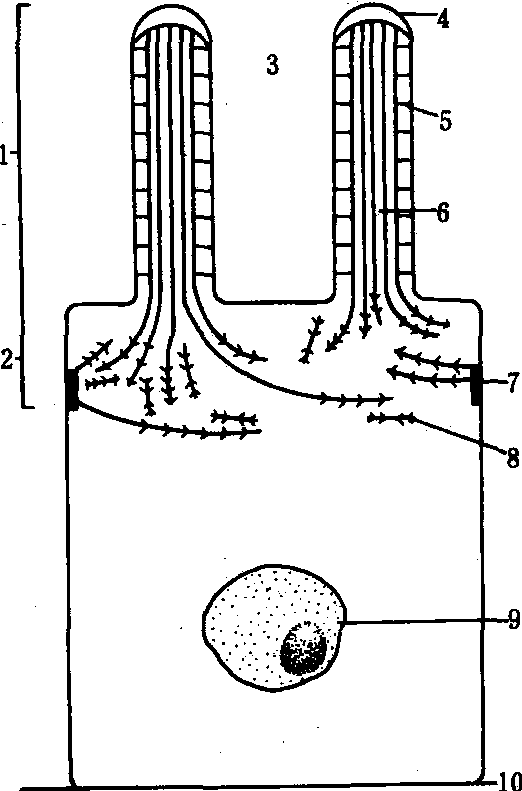细胞运动cell movement
细胞体和细胞内的有形成分在时间和空间中的位置变动。它是自主的生命行为,需细胞付出能量对环境作机械功。它使细胞和生物体对环境中各种影响因子作出及时的行为反应,以产生趋利、避害、摄食、排废、交配和发育等生物学效果。它亦是在物理学上可逆的变化,不同于生长运动的不可逆过程。
细胞的运动机制除原核生物的细菌鞭毛运动外,真核生物主要为微丝和微管两大运动系统,还有少数其他机制。
微丝运动系统 普遍存在于真核细胞,包括大部分细胞内运动及细胞体的变形、伸缩运动。肌肉是它最完善的结构形式,是一切高等动物运动(包括脏器运动和各种行为,如奔跑、跳跃、游泳和飞翔等)的基础。
细胞质流动 主要存在于植物细胞,是细胞质成分有规律的长距离运动,有扰动(或跃动)、循环和旋转等形式。即使是无定向的扰动,亦区别于随机的分子热运动(布朗运动)。当细胞质微丝穿越中央液胞时,出现循环运动,在不同时间、部位和质点间,可改变流动方向。当细胞质微丝被挤在中央液胞外周时,细胞质作定向流动,即旋转运动,亦称原生质环流。在拟轮藻的巨大多核节间细胞、紫鸭跖草的雄蕊毛细胞、洋葱鳞茎内表皮细胞、水稻的根毛细胞和蚕豆的花粉中均有这种运动形式。其动力为分散的胞质微丝作用。
胞质分裂 在细胞分裂末期,细胞赤道处出现由微丝组成的收缩环,它使细胞质在此部位不断缢缩,最后分割成两个子细胞。
精子顶体突起 某些动物,如鲎的精子顶体有预先由肌动蛋白组成的突起,当受精时可迅速伸出; 海参的精子顶体贮备了大量肌动蛋白单体,当受精时能及时聚合成突起而生长。它们均能突破卵表面的保护层,利于精子入卵。
叶绿体趋光运动 转板藻细胞中仅有一个大型板状叶绿体,它在强光下以窄的侧面向光,而在弱光下则以宽的正面向光。此反应由光敏色素感受,由胞质微丝推动。
细胞吞吐及膜流 吞噬泡形成时有细胞膜的上卷和包围现象,是因膜受体和被吞颗粒表面的配体间产生“拉链作用”所致; 同时胞质外质在微丝网络的支持下形成伪足,包围颗粒而成吞噬杯; 接着局部胞质Ca2+浓度升高,引起外质溶胶化以便吞噬杯沉入内质,终成吞噬泡; 后Ca2+浓度复又下降,微丝网络重建,以防溶酶体直接与胞膜接触而融合,只能与吞噬泡融合,形成次级溶酶体 (见溶酶体及胞吞作用)。内质网、高尔基复合体、溶酶体、分泌颗粒等成分的膜和核被膜、质膜在细胞内的定向迁移和周转统称膜流,也靠微丝起协调作用。
变形运动 细胞依靠形成各种形状的伪足而运动,肉足纲的原生动物、粘菌变形体期、大新杆状圆虫的精子及后生动物的早期胚胎细胞均有此类运动。其机制为胞质微丝结构的可逆变化,引起细胞质的外质和内质间发生溶胶一凝胶的相变,从而推动细胞体前进。
培养中的成纤维细胞也能在培养基基质上爬行。这是由于向前延伸的细胞膜上有纤维粘连蛋白的受体,它反复与培养基基质中的配体分子相结合而被锚着,细胞前端的膜因胞吐作用不断向前扩展,侧面和后端的膜因胞吞作用不断收缩,由于膜的流动引起细胞体的运动。
伸缩运动 与变形运动不同,细胞体的伸长和缩短是反复可逆的。喇叭虫(纤毛纲)细胞内有微丝组成的类肌丝,收缩时细胞呈梨形,伸展时恢复喇叭形。在后生动物的消化道和其他管状结构内衬的上皮细胞表面常见有微绒毛,它以伸缩和摆动来调节上皮细胞的吸收作用,微绒毛内部的微丝,一端固着于顶端,另一端固着在终末蹼网或细胞侧壁的连接复合体上,与肌球蛋白相作用而伸缩(见图)。

小肠上皮细胞微绒毛运动机制
1. 肌动蛋白微丝; 2. 刷状缘;3. 肠腔; 4. 绒毛顶端固着处;5. 与质膜交联处;6.蛋白微丝;7. 紧密联接; 8. 肌球蛋白;9. 细胞核; 10. 基膜
从腔肠动物的肌上皮开始,逐渐进化出现了一系列专门实行伸缩运动的肌细胞(见微丝)。
微管运动系统参与某些细胞内运动,如神经轴突流、昆虫卵巢营养管流和太阳虫的轴足流等。细胞分裂器使染色体定向运动也属此系统。当微管组成鞭毛或纤毛结构时,即成为专职的运动细胞器。
神经轴突流在神经细胞的轴突内有很多平行排列的微管束、少量的微丝和居间丝,主要依靠微管推动质点在轴浆内流动。它分为快速和慢速两种,除运送蛋白质和脂类等分子外,还能运输有膜包被的分泌颗粒、单胺囊泡及线粒体等。除从细胞体向末梢的正向流外,还有从末梢向细胞体的逆向流,如神经生长因子和破伤风毒素蛋白即以逆向流作用于神经细胞体。
昆虫卵巢营养管流 半翅目昆虫卵巢中,前端的滋养细胞通过营养管与发育中的卵细胞相联,该管长约3mm,粗约20μm,中有30 000条并列的微管,大量的营养物质和RNA、核糖体及线粒体经此被输入卵内。
原生动物特殊摄食方式 肉足纲的太阳虫伸出有微管为轴的伪足,称轴足,它能将食物颗粒带入细胞体。纤毛纲的吸管虫用触手顶端捕捉其他的纤毛虫,并将猎物的细胞内容物通过触手内部管道吸入食物泡。此管道由一圈外周的单微管和内圈的7组7个微管结构合围而成。
合胞体中细胞核集聚运动 用动物病毒诱导培养细胞形成的合胞体,其中所含的几百个细胞核并不处于分散状态,而由微管推动并聚集在合胞体中央。
有丝分裂器 细胞在有丝分裂时,约由3 000根微管组成纺锤形的分裂器,以指引染色体的复杂运动。
鞭毛和纤毛运动 真核细胞的鞭毛与纤毛依靠在液态介质中往复摆动而使细胞体前进。在雷诺数(惯性力/介质粘性力)较小的条件下,即运动的物体较小和介质粘度较大时运动效率较高。很多单细胞生物和多细胞生物的游离细胞均靠此机构运动。
其他运动系统 两栖类和底栖鱼类表皮色素细胞中含有色素颗粒,它受神经支配调节其集散状态。过去认为受微管控制,现认为可能是微梁网络的功能。
某些孢子虫,如Selenidium的营养虫体能吸附在宿主肠壁上,并产生有节奏的扭动而钻入肠腔;簇虫及某些藻类细胞可在基质上滑行而不需改变细胞形状,其运动原理不明。
细胞依靠内部膨压变化而运动有两种形式: ❶不可逆的。如腔肠动物的刺细胞和纤毛虫的刺丝泡;
❷可逆的。如高等植物的叶枕细胞依靠液泡内液的排放和重吸收,引起叶片的下垂和竖直。
纤毛纲的钟形虫有长柄状结构,使细胞附着在固体表面,柄部内部有痉轴丝, 能作突发的收缩运动。它虽非微丝结构,但亦具伸缩功能。